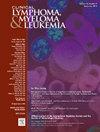健康的社会决定因素对外周 T 细胞淋巴瘤预后的影响:治疗中心类型成为强有力的预后指标
IF 2.7
4区 医学
Q2 HEMATOLOGY
引用次数: 0
摘要
背景:外周T细胞淋巴瘤(PTCL)的预后模型已确定年龄、表现状态、低密度脂蛋白胆固醇(LDH)和BM受累等生物学因素是生存的预后因素。健康的社会决定因素(SDH)对PTCL预后的影响仍未得到探讨:为了评估可操作的 SDH 对不同种族群体 PTCL 死亡率的影响,我们开展了一项回顾性队列研究,研究对象包括 2000-2020 年期间在加利福尼亚州确诊的所有白人、西班牙裔、亚太裔(PI)和黑人结节性 PTCL 成年患者。我们使用Chi2和Wilcoxon秩和检验进行描述性指标分析,使用Kaplan-Meier统计进行死亡率估算。回归模型包括患者因素(年龄、性别、种族、分期、查尔森综合指数、组织学、治疗、学术中心治疗、付款人)和社区因素(社会经济(SES)五分位数、无高中文凭的比例、农村/城市)。单变量回归中P<.10的重要风险因素被纳入多变量模型:我们的分析包括 6158 名患者:51.8%为白人,25.8%为西班牙裔,14.7%为亚裔/西班牙裔,7.6%为黑人。西班牙裔患者的中位生存期最长(33 个月),其次是白人、黑人和亚裔/西班牙裔患者(分别为 25 个月、20 个月和 14 个月;P = .011)。与淋巴瘤特异性生存期(LSS)较差独立相关的风险因素包括:亚裔/PI 与 NH 白人相比(HR,1.23;95% CI,1.10-1.34;P = .0002);AITL/ALCL 与 PTCL、NOS 相比(AITL HR,1.14;95% CI,1.02-1.25;P = .011;ALCL HR,1.15;95% CI,1.04-1.26;P = .004);学术机构与非学术机构类型相比(HR 0.71;95% CI,0.64-0.77;P < .01),医疗保险与无保险相比(HR 1.48,95% CI,1.25-1.73;P < .01),以及教育程度最低的3个四分位数与教育程度最高的4个四分位数相比(Q2 HR 1.13;95% CI,1.01-1.25;P = .021;Q3 HR 1.14;95% CI,1.02-1.26;P = .018;Q4 HR 1.22;95% CI,1.08-1.36;P < .001)。在资源最匮乏的患者中,组织学、治疗方法、治疗机构类型、付款人和教育程度是LSS的独立预后因素。学术中心的治疗与 LSS 的显著改善有关(学术机构:是 = 101 个月,否 = 17 个月;P < .01):治疗机构类型、付款方和教育程度是影响 PTCL 死亡率的独立可操作 SDH。治疗中心类型与 LSS 的预后关系最为密切,可使 PTCL 死亡率风险降低近 30%。本文章由计算机程序翻译,如有差异,请以英文原文为准。
The Impact of Social Determinants of Health on Peripheral T Cell Lymphoma Outcomes: Treatment Center-Type Emerges as a Powerful Prognostic Indicator
Background
Prognostic models in peripheral T cell lymphoma (PTCL) have identified biological factors including age, performance status, LDH, and BM involvement as prognostic for survival. The association of social determinants of health (SDH), on PTCL outcomes remains unexplored.
Methods
To evaluate the impact of actionable SDH on PTCL mortality across race groups, we conducted a retrospective cohort study that included all White, Hispanic, Asian/Pacific Islander (PI) and Black adult patients with nodal PTCLs , diagnosed 2000-2020, in California. We utilized Chi2 and Wilcoxon rank-sum tests for descriptive metrics and Kaplan-Meier statistics for mortality estimation. Regression models included patient- (age, sex, race, stage, Charlson Comorbidity Index, histology, treatment, academic center treatment, payer), and neighborhood-level factors (socioeconomic (SES) quintile, proportion without a high school diploma, and rural/urban). Risk factors significant in univariate regression of P < .10 were incorporated into the multivariable model.
Findings
Our analysis included 6158 patients: 51.8% White, 25.8% Hispanic, 14.7% Asians/PI, and 7.6% Black. Hispanics exhibited the longest median survival (33 months) followed by Whites, Blacks, and Asian/PI (25, 20, and 14 months, respectively; P = .011). Risk factors independently associated with inferior lymphoma-specific survival (LSS) included Asian/PI compared with NH Whites (HR, 1.23; 95% CI, 1.10-1.34; P = .0002), AITL/ALCL compared with PTCL, NOS (AITL HR, 1.14; 95% CI, 1.02-1.25; P = .011; ALCL HR, 1.15; 95% CI, 1.04-1.26; P = .004), academic compared to nonacademic facility-type (HR 0.71; 95% CI, 0.64-0.77; P < .01), Medicare compared with uninsured (HR 1.48, 95% CI, 1.25-1.73; P < .01), and the lowest 3 compared to the highest education quartiles (Q2 HR 1.13; 95% CI, 1.01-1.25; P = .021; Q3 HR 1.14; 95% CI, 1.02-1.26; P = .018; Q4 HR 1.22; 95% CI, 1.08-1.36; P < .001). In the least resourced patients, histology, treatment, treatment facility-type, payer and education were independently prognostic for LSS. Academic center treatment was associated with a striking improvement in LSS (academic institution: yes = 101 months, no = 17 months; P < .01).
Interpretation
Treatment facility-type, payer and education, areindependent actionable SDH for PTCL mortality. Treatment center-type had the strongest prognostic association with LSS, conferring a risk reduction of PTCL mortality by nearly 30%.
求助全文
通过发布文献求助,成功后即可免费获取论文全文。
去求助
来源期刊

Clinical Lymphoma, Myeloma & Leukemia
ONCOLOGY-HEMATOLOGY
CiteScore
2.70
自引率
3.70%
发文量
1606
审稿时长
26 days
期刊介绍:
Clinical Lymphoma, Myeloma & Leukemia is a peer-reviewed monthly journal that publishes original articles describing various aspects of clinical and translational research of lymphoma, myeloma and leukemia. Clinical Lymphoma, Myeloma & Leukemia is devoted to articles on detection, diagnosis, prevention, and treatment of lymphoma, myeloma, leukemia and related disorders including macroglobulinemia, amyloidosis, and plasma-cell dyscrasias. The main emphasis is on recent scientific developments in all areas related to lymphoma, myeloma and leukemia. Specific areas of interest include clinical research and mechanistic approaches; drug sensitivity and resistance; gene and antisense therapy; pathology, markers, and prognostic indicators; chemoprevention strategies; multimodality therapy; and integration of various approaches.
 求助内容:
求助内容: 应助结果提醒方式:
应助结果提醒方式:


